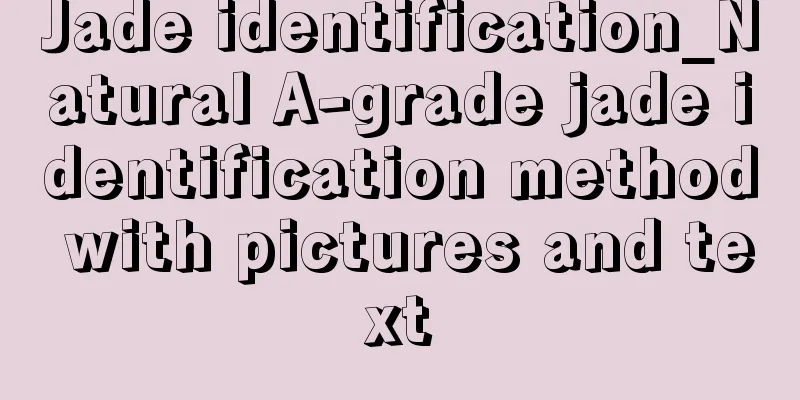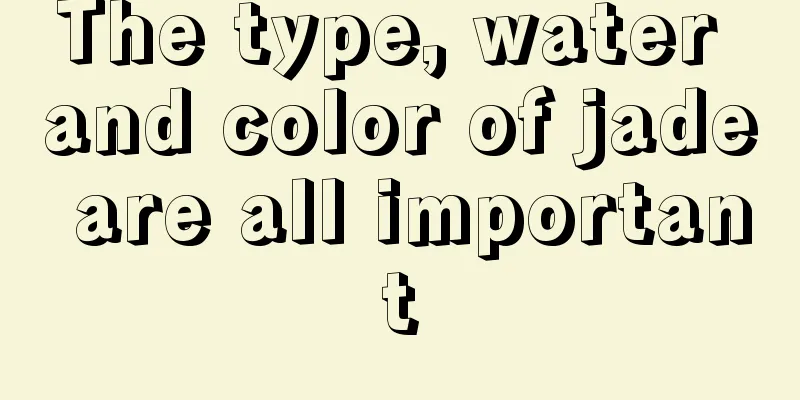Jade identification_Natural A-grade jade identification method with pictures and text

|
Commercial-grade, collectible jade is produced only in Myanmar. Regardless of the amount of Burmese jade reserves or the amount of jade mined, good jade is very limited. Therefore, some speculators and profit-seeking businessmen have counterfeited and sold it in large quantities to make a profit. Even in Myanmar, the kingdom of jade, fakes are everywhere, so it is particularly important to know how to identify jade. To identify jadeite, you must first understand jadeite. What is the difference between jadeite and jade ? This is the first thing to understand, and then comes the identification characteristics of jade similar to jadeite. In this article, Wuluhe Jade Network focuses on introducing the identification features of A-grade jade and imitation jade. Identification of JadeThe identification of jadeite is mainly based on its characteristic granular to fibrous interwoven structure. The jadeite's green properties are measured by instruments, with a refractive index of 1.66, a specific gravity of around 3.32, and an absorption spectrum in the purple region of 4.37 nanometers. Green jadeite has the highest value and is the object of counterfeiting. To learn how to identify jadeite, one must learn how to identify green jadeite. The following are some identification features of jade that is similar to green jadeite. Emerald glass jadeite Dyed fake jade bracelet Identification of Jadeite Similar to JadeiteIdentification of Dyed Quartzite Jade This is the most common jade imitation on the market. The most obvious difference between this jade and jade is that its structure is granular, and its refractive index and specific gravity are also significantly smaller than jade. Dyed Quartzite Bracelet Identification of Grossular JadeGrossular garnet jade also has a granular structure, and its green color is distributed in dot-like spots. Its hardness exceeds that of jadeite. Due to its high hardness, it is not easy to polish, so its gloss is generally poor. The green part of grossular garnet jade turns red or orange-red under the Charles filter. Its refractive index and specific gravity are significantly higher than those of jadeite, and it can be distinguished from jadeite. Identification of Nepheline JadeAlso known as " Shuimozi ", it is a kind of jade that associates (symbiotically) with Burmese jadeite. The difference between Shuimozi and jadeite is not easy to observe, and its identification characteristics are very similar to those of jadeite. Its characteristics are particularly good transparency and common white floc-like stone flowers, which are rarely seen in jade. In addition, its refractive index and specific gravity are significantly smaller than jadeite. Identification of Green Xiuyan JadeXiuyan jade, with its very dense structure and high transparency, is similar to glass-type jadeite. A common feature of Xiuyan jade is white cloud-like lumps. Instrumental measurement reveals that the refractive index of its specific gravity is significantly lower than that of jadeite. In addition, most Xiuyan jade can be scratched by a knife, but jadeite cannot. It has a certain background color and scattered dots of bright green. Its luster is strong, even stronger than jadeite. Due to its high density, it is very easy to be confused with green jadeite. Light green Xiuyan jade bracelet Identification of JasperThe jasper in Hetian jade is similar to green jadeite. Jasper is generally finer in structure than jadeite, with a more even distribution of color and often black spots. When identified by instruments, it can be seen that its specific gravity and refractive index are lower than those of jadeite. Identification of ChrysopraseGreen chalcedony is similar to high-grade green jadeite due to its good transparency, high hardness and uniform color. The color of green chalcedony generally presents a distinct yellow-green hue. It is lighter in color, does not have the color roots and color veins of jadeite, and does not have the chromium absorption lines characteristic of green jadeite. No obvious structure can be seen under a magnifying glass, and instrumental identification shows that the specific gravity and refractive index are significantly lower than those of jadeite. Green Chalcedony Ring Identification of glassThe color of imitation jade glass is relatively uniform and does not have the "color roots" of jade. Bubbles are often seen, especially in early materials, where the bubbles are particularly obvious. Although the bubbles in modern imitation jade glass with better production technology are relatively small, they can be seen with a 10x magnifying glass and a flashlight, and are mostly small pink-green spheres. The refractive index and specific gravity are also significantly smaller than jadeite. A devitrified green glass has radial, grassy, or mosaic patterns, while another type of glass, called "South African jade," has fern-like patterns when slightly magnified with a magnifying glass. fcgc66 fcpf18 |
<<: How to distinguish jadeite from water foam?
Recommend
The original jadeite from Damakan is exquisite and lovely after being carved
"One cut can make you poor, another cut can ...
Emerald leaves are more perfect because of you
"One flower, one world; one leaf, one bodhi&...
Jade can also get sick, why? Let’s take a look
People eat whole grains. Who can be free from ill...
The ice-type jadeite sheet material is simply made into a solemn Guanyin pendant, the effect is amazing!
This is a piece of ice-type jadeite. The texture ...
Jade can undergo such a huge change after being processed from raw stone to finished product!
Jade is a mysterious type of jade. Every process ...
Jade processing requires particularities. Material selection is an important beginning, and cutting is a key link. How to position it?
Man takes care of jade for three years, and jade ...
A lovelorn woman traveled and spent 35,000 yuan to buy 20 kilograms of jadeite, but unexpectedly cut out 46 jadeite bracelets
We often hear the saying that nine out of ten tim...
Beautiful colors and clever carvings! The icy red jadeite carving is stunning and so beautiful!
This work is made from an old pit ice jadeite, wh...
Picking up an inconspicuous Damakan jadeite rough stone, its value increased thirty times after being made into a finished product!
The jadeite raw stone was originally just a piece...
Do you know the story of Jade?
This has to start with the first person to collec...
Appreciation of jade ornaments, so beautiful
"Wealth-Attracting Pixiu - Seal" (Jadei...
Knowledge points for identifying natural jadeite—the "cotton" of jadeite
Many people will carefully observe when buying an...
Can the cut material be brought back to life? I only admire him for jade carving
As the saying goes, nine out of ten pieces of jad...
The "Emerald Great Wall" worth 560 million yuan is not only due to its high quality but also its spicy color.
At the 26th Paris Antiques Biennale in Hong Kong,...
What is celadon jadeite? Did you know?
Many friends in the jade market are confused when...









